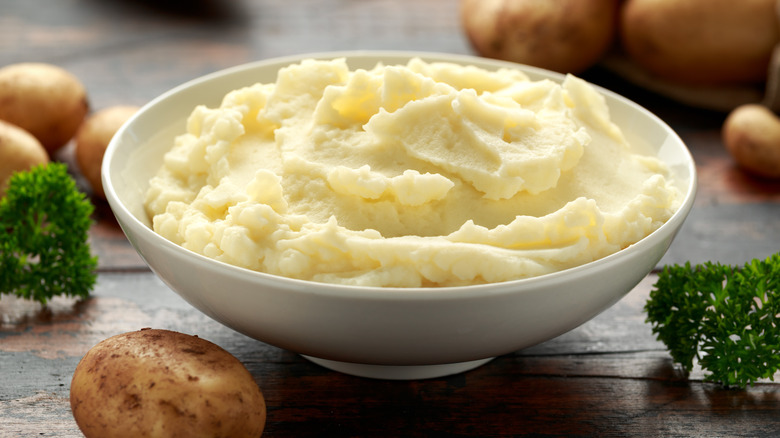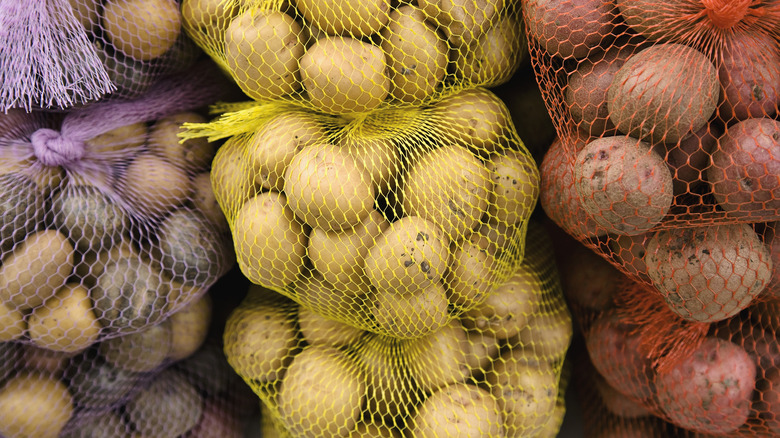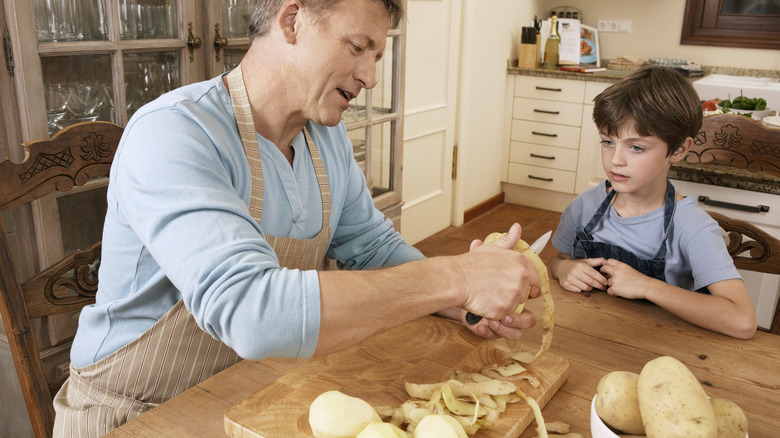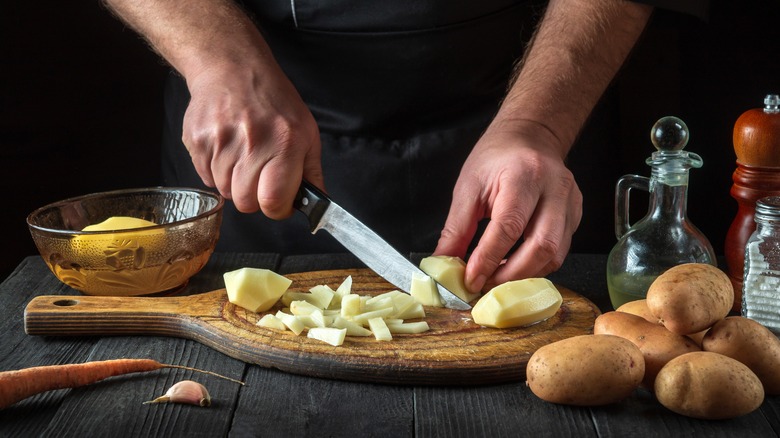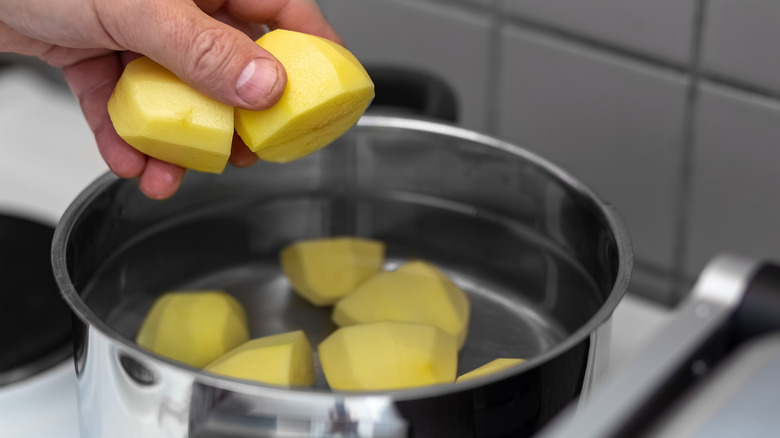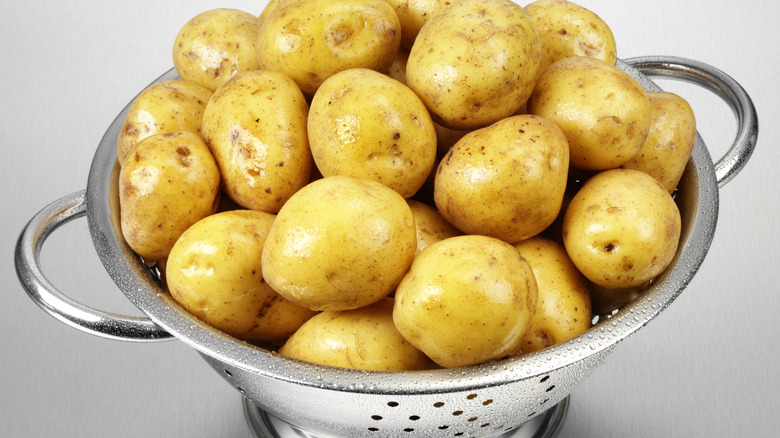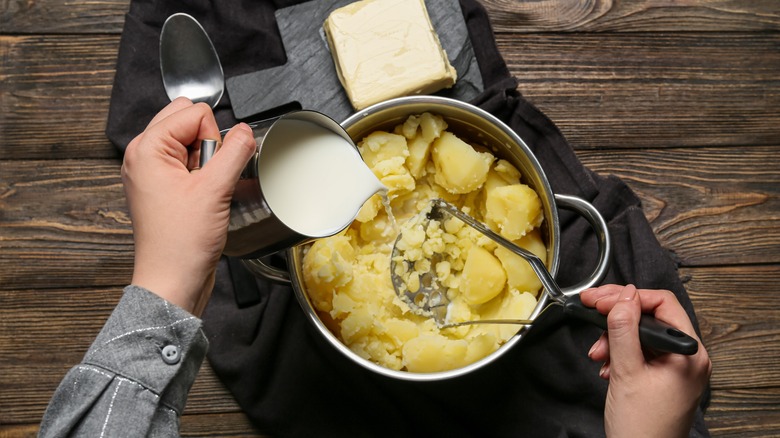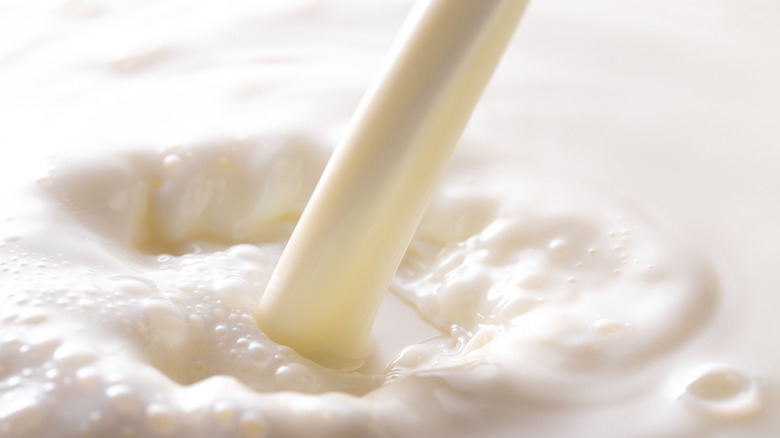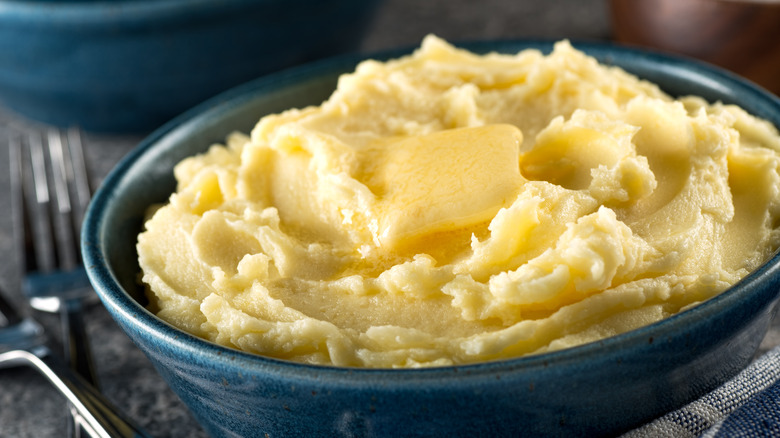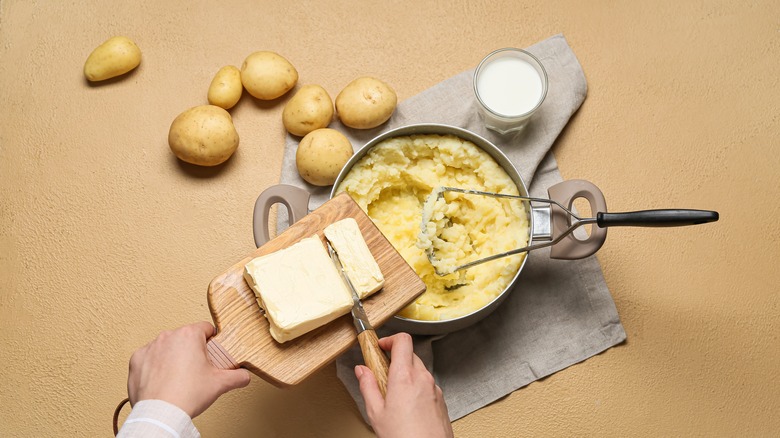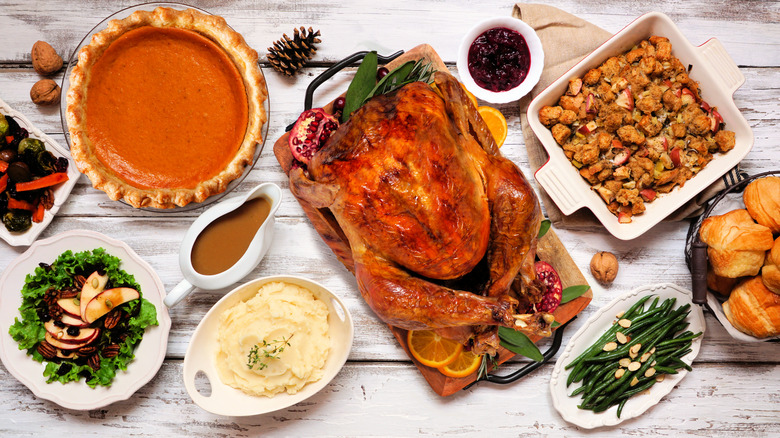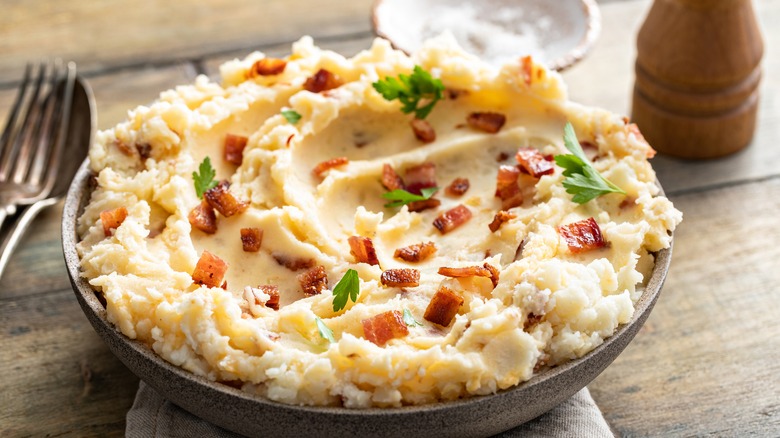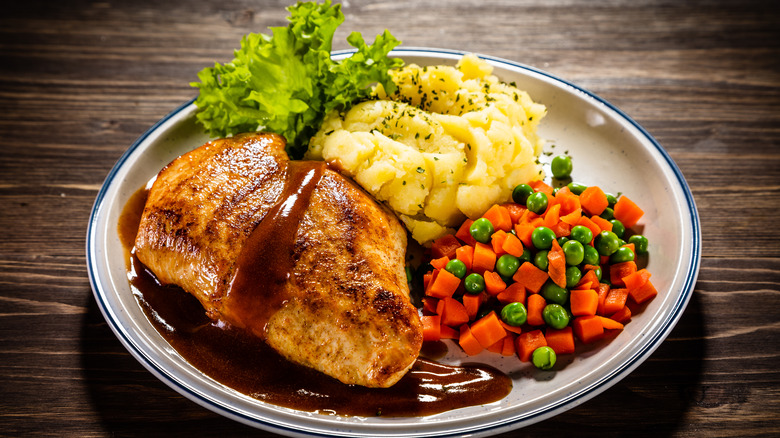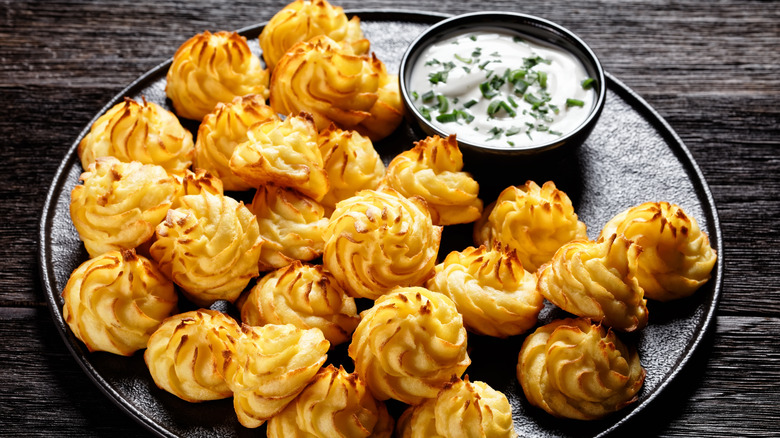16 Mistakes To Avoid When Making Mashed Potatoes
Mashed potatoes are one of those side dishes that have graced countless dinner tables. When it comes to potatoes, in particular, they are a hit amongst countless people in the U.S. In fact, according to Perishable News, the average American eats around 111 pounds of potatoes each year — as of 2018. That's a lot of potatoes.
While the origin of mashed potatoes isn't as clear as we'd like, the first recipe that used butter and cream was documented in a mid-18th-century cookbook written by Hannah Glasse called "The Art of Cookery." When made right, mashed potatoes can be smooth, buttery, and utterly delectable.
However, this is only true if they're prepared correctly. Otherwise, your mashed potatoes can turn out lumpy, runny, cold, or simply lacking in flavor. Making mashed potatoes doesn't have to be difficult, but there are certain mistakes that you'll want to be careful to avoid. If not, the results could be disastrous.
1. Not choosing the right type of potato
All potatoes are the same, so it doesn't matter which type you use to make your mashed potatoes, right? If you've been operating on this way of thinking, then you've been making a mistake when preparing your mashed potatoes. There are actually several different types of potatoes. They may be classified into three main categories based on their texture: Starch potatoes, waxy potatoes, and all-purpose potatoes.
When you're making mashed potatoes, it is important to choose a starchy potato. This type tends to be better in terms of absorbing the butter, cream, and any added seasonings. Yukon golds and russets are two examples of starchy potatoes that can work well. Stay away from red potatoes and other waxier options. With their lower starch content, they won't hold enough water during the cooking process, leaving the final product too firm to make the classic smooth and creamy mashed potatoes you know and love.
2. Peeling the potatoes without washing them first
Potatoes should always be washed before using. They grow underground, and while some of the dirt is brushed off before they make it to the grocery store, they are not properly washed and ready to use before you buy them. If you are thinking that you're just going to peel off the dirty skin anyway and that it doesn't matter if you wash it first or not, think again. If you don't wash them before peeling, you're simply going to be spreading the dirt, pesticides, and other contaminants over the rest of the potato as you remove the peels.
To wash your potatoes, run them under running water and thoroughly scrub them using a vegetable brush. After peeling, rinse the potatoes one more time to remove any lingering dirt or germs. While we're on the subject of making sure your potatoes are clean before using them to make mashed potatoes, you also might want to consider purchasing organic potatoes over their conventional counterparts.
Potatoes are considered one of the dirtiest produce items in terms of the amount of pesticides they hold — not just on the skin, but also that gets absorbed into the potato itself. Because organic potatoes are grown without pesticides, you don't need to worry about the potential concerns they can pose.
3. Cutting the potatoes into chunks that are too large or too small
After you've peeled your potatoes, the next step will be slicing and dicing them. It is important to cut them to the right size. If you cut them into slices, cubes, or pieces that are too thin, they're going to absorb too much water as they cook. This can leave them waterlogged and unable to absorb the milk and cream when you're ready to mix all the ingredients together.
If the chunks of potatoes you cut are too small, they're also more likely to crumble apart as they cook in the water, leaving more waste when you drain them. While you don't want your potatoes to be cut too small, you also don't want to cut them into huge chunks.
If the potato pieces are too large, they're going to take longer to cook, which can throw off your timing. And you could end up draining the pan before they're tender enough, which could result in lumpy potatoes. Aim to cut your potatoes into 1 ½-inch cubes. This size will be large enough to prevent the potatoes from becoming saturated with water but small enough to ensure they cook evenly and come out nice and tender.
4. Putting the potatoes into the water after it starts boiling
Boiling potatoes is not like boiling pasta. While you want to bring a pot of water to a boil before you add your pasta, the opposite is true with potatoes. You should always start with the potatoes in cold water, then you can bring them to a boil. This will help ensure that the potatoes cook evenly. If you drop the potato chunks in a pot of boiling water, then the outside of each piece is going to cook faster than the inside.
To properly boil your potatoes, start by putting them in a large pot. Add enough cold water to cover the potatoes, and about 1 inch more. Place the pot on the burner over medium-high heat, and bring it to a boil. Once boiling, remove the lid, reduce the temperature, and let the potatoes simmer until tender. As the water is coming to a boil, stay close by to make sure that the pot doesn't overflow. Otherwise, you'll be left with a starchy and watery mess all over your burner and stove to clean up.
5. Not adding salt to the water
While boiling potatoes is different from cooking pasta because of the ideal water temperature for adding each ingredient, there is one key similarity between cooking the two foods. You should always properly salt your pasta water as well as your potato water. Salt is important for adding seasoning and flavor to your potatoes, helping ensure that your mashed dish tastes the way you want them to.
If you want to add any additional seasoning to your mashed potatoes, you can also add them when the potatoes are cooking. A few that you could consider include thyme, black pepper, and bay leaves. Salting the water is also an important component of the cooking process. When you add salt to the water, it allows your items to reach a higher temperature when it is boiled. The boiling water will be able to do a better job at cooking the starches in the potato fully, allowing you to achieve exceptionally creamy mashed potatoes.
6. Not cooking the potatoes for the correct amount of time
Another big mistake many people make when cooking potatoes is overcooking or undercooking them. Both of these options will not result in the rich, creamy, and delicious mashed potatoes you desire. Overcooked potatoes will have taken on too much water and will fall apart as you try to mash them, leaving your mashed potatoes too liquidy.
On the other hand, if the potatoes are undercooked, they'll be too firm and won't mash up nicely. This can result in lumpy and hard mashed potatoes that won't fully absorb all the butter and milk, thus, throwing off all the flavors.
There is no one set answer for how long potatoes should boil when making mashed potatoes, as it can vary depending on the size of the pieces you cut. As a general rule, however, plan for it to take between 15 and 20 minutes for them to cook. You'll know that the potatoes have finished cooking when you can easily cut into them with a fork or a knife.
7. Not removing enough water from the potatoes before beating them
Texture and consistency are crucial when it comes to making mashed potatoes. However, getting these two components right can be a tricky skill to master. One problem that many people run into is that their mashed potatoes turn out watery rather than thick and creamy. If this has been happening to you, it could be because your potatoes are too wet before you start beating them.
If the potatoes are holding too much water after boiling, it only makes sense that the water will be released as they are beaten, leaving you with a mushy mess. To avoid this problem, there are a few things you should do. First, you want to make sure you thoroughly drain all the water from the potatoes. After they've finished cooking, place a large colander in your sink and pour the pot of potatoes and water into it.
Give it a few good shakes to get rid of as much water as possible. Instead of starting to mix the potatoes right away, return them to the pot and place them over a burner on low heat. Leave them over heat for about 5 minutes to help dry off any remaining water on the surface of the potatoes. Periodically flip the potatoes over to keep them from sticking.
8. Adding too much milk
When adding milk to your mashed potatoes, only add a little at a time. It takes less than you might think — you just need enough to thin them out ever-so-slightly and make them nice and creamy. Just like when your potatoes are too wet at the start, if you add too much milk to your mashed potatoes, they're going to be runny and liquidy. While you can always add more milk if needed, you can't exactly take milk out if you end up adding too much.
However, if you do end up adding too much milk, there are a few things you can do to try and thicken the potatoes. For starters, you can add about 1 teaspoon at a time of a thickening agent — such as cornstarch, tapioca, or powdered milk — until the potatoes reach the desired consistency.
Sometimes heating the potatoes in the oven for a few additional minutes can help pull out some of the excess liquid. A third option to try is to add a hard cheese, such as parmesan or pecorino, to absorb some of the excess liquid and thicken the mixture. While none of these options are entirely ideal, they're better than letting a whole bowl of mashed potatoes go to waste.
9. Using low fat milk
If you want the best-tasting mashed potatoes, you'll have to forget about counting calories or carbs for a bit. The truth is that you're just not going to be able to get thick and creamy mashed potatoes if you use skim or low-fat milk. You need something with a higher fat content, either cream or whole milk. Skim milk is better for you because the fs is removed from the milk.
When too much fat is removed from milk, it makes it harder to achieve that delectable, rich, and creamy mashed potatoes recipe. If you just look at a glass of skim milk next to a glass of cream, you can immediately notice the difference. The skim milk is much thinner and moves more freely around the glass.
The cream, on the other hand, is thick, moves slowly, and even sticks to the sides of the glass after it passes over it. If you're looking for extra thick and creamy mashed potatoes, you might want to consider incorporating some sour cream into the mix. Adding sour cream to your mashed potatoes recipe is great because it's even thicker than cream and will coat each potato, creating a creamy consistency.
10. Skimping on the butter
You should not skimp on the butter when making mashed potatoes, as it is arguably one of the most important ingredients in this recipe. If you do not use enough butter, you and all of your guests are going to notice that the flavor — and quite possibly, the texture — of the potatoes is off. Buttery mashed potatoes are simply better than those made with little to no butter.
The exact amount of butter you will want to use will vary based on your individual preferences. While some chefs may recommend using a full stick for every pound of potatoes, that may turn out too rich for you. Somewhere closer to half of a stick may be more in line with what you're looking for.
It might take you a few times of making mashed potatoes to determine the ideal amount of butter for your tastes. The best way to figure this out is to experiment using different amounts of butter, just remember, less might not be more in this case.
11. Not softening the butter and warming the milk before mixing them with the potatoes
When you make mashed potatoes, do you do anything to the milk and butter before you add them in? If you've simply been cutting butter from a cold stick or pouring milk directly out of the refrigerator, then you've been making a big mistake. Adding cold milk and cold butter will make your potatoes colder a lot faster. And rarely are dinner guests craving a big bowl of cold mashed potatoes.
It's also important to note that if you add cold butter to your mix, it simply isn't going to blend as well with the potatoes. Cold butter is hard and won't fully melt, which could leave you with lumpy potatoes. Think about it — would you want to bite into cold starchy potatoes half mixed with large chunks of butter? Probably not.
Fortunately, both of these problems are easy to avoid. Warm your milk up for a few seconds in the microwave. It doesn't have to be boiling hot, but you want to at least get the chill off of it. For the butter, you don't want to completely melt it, as that, too, can mess up the consistency of the mashed potatoes. Rather, give it about 8 to 12 seconds on 30% power, then flip it over and give it an additional 8 to 12 seconds on 30% power. This should soften it so that it will blend in nicely, but not leave it melted and liquidy. Another option is to pull the butter out of the refrigerator about an hour or so before you will need it.
12. Over whipping the potatoes
If you prefer using an electric hand mixer to whip your mashed potatoes, you're not the only one. Hand mixers can simplify the task of breaking up and smoothing out the potatoes and help make sure they are well combined with the milk and butter. However, if you do prefer to use a hand mixer, you need to take care to avoid over-whipping the potatoes. Once they're smoothed out, and all of the ingredients are incorporated together, turn off the mixer.
Any time you break down potatoes, either with a hand mixer or a masher, they release starch. Some starch isn't going to negatively impact your mashed potatoes. However, they continue releasing more starch as you continue mashing or whipping them. So, if you run your electric mixer more than is necessary, the potatoes are going to end up releasing excessive amounts of starch. If this doesn't sound very appetizing, you're right. Too much starch in your mashed potatoes will leave them with a gummy, sticky, or powdery consistency.
13. Not keeping the mashed potatoes warm before serving them
You don't want to go through all of the trouble of making mashed potatoes only to have them get cold before you're ready to serve the meal. Timing a meal can be difficult, but you want to try to get it to work out so that the mashed potatoes will be one of the last things finished.
Thinking about the time you plan on serving dinner and working backward from there can help you determine when you should start the potatoes. Since they'll take about 15 to 20 minutes to cook and about 5 to 10 minutes to mash, aim to put them on the stove about 40 minutes or so before you plan to eat. Keep in mind that this estimate assumes that you have already washed, peeled, and cut the potatoes. If you'll be doing all the prep work, leave yourself about an hour to get the potatoes ready.
If your mashed potatoes end up finishing faster than anticipated, or another component of your meal is taking longer than expected, you can keep the potatoes warm. To do this, cover the bowl with a dishtowel, put the potatoes in the slower cooker, or put the bowl in the microwave — turned off. Think about how much time is left before you plan on serving your meal to determine which of these options is the best choice.
14. Not considering an add-in to upgrade your recipe
While mashed potatoes made using only butter and milk or cream can be perfectly enjoyable, you may be getting tired of using the same old recipe. Or, perhaps, you're looking to make mashed potatoes for a special gathering and want to really impress others. Either way, you should be thinking about upgrading the taste of your potatoes with an add-in.
There are many different add-in options when it comes to making mashed potatoes. Consider the type of meal you're making and which flavors will best complement it to help you choose the best add-in. Cheese is one of the more popular add-ins. Another fan favorite is bacon. Recipes like delicious bacon and chive mashed potatoes are certain to be a crowd-pleaser at your next event.
A few other less common but still tasty options include ranch seasoning, jalapeño peppers, garlic, and even salsa. If you're feeling undecided about what to add to your mashed potatoes, consider making some loaded mashed potatoes with cheese, bacon, green onions, and any of your other favorite toppings.
15. Not choosing the right main dish to serve with the potatoes
When you make mashed potatoes, you want to be confident that they'll add to the overall meal you're preparing. While mashed potatoes can make a wonderful side for many main dishes, there are certainly some that they won't pair well with. For example, you might enjoy serving mashed potatoes as a side dish with mac and cheese, steamed vegetables, or pan-seared butter-basted rosemary steak, meatloaf, pork chops, or even fish.
The warm and buttery potatoes can even serve as a nice dip to help enhance the flavor of the meat or fish on the plate. Mashed potatoes also go great with fried chicken and barbecue dishes — really, most savory proteins pair well with this dish.
If you just put a little thought into how the different flavors and textures will or won't work together, you shouldn't have trouble deciding what to serve with mashed potatoes. On the other hand, you might want to avoid serving mashed potatoes with chicken pad see ew, birria tacos, or avocado toast as these flavors are all so prominent on their own that they will clash.
16. Not finding creative ways to use up the leftovers
After whipping up some mashed potatoes for your dinner guests, you may find that you made a little too much and have plenty of leftovers. After all, a little goes a long way with hearty and filling dishes like this one. Still, it's definitely better to make too much than not enough, so this isn't really a bad problem to have — especially if you're hosting a dinner. You have a few options when it comes to enjoying your leftovers. First, you can simply warm up the mashed potatoes with a few additional drops of milk and eat them the following day.
Another option is to experiment with different foods and ingredients. There are several different recipes that call for mashed potatoes that you can try making with your leftovers. An easy option is to heat up your mashed potatoes in a pan and add in some cheese, bacon, and a little sour cream. Now, instead of the classic buttery potatoes, you have loaded mashed potatoes to serve with your next meal. You can also use the leftover mashed potatoes to make pierogies, gnocchi, cheesy potato pancakes, shepherd's pie, mashed potato croquettes, and so much more.
